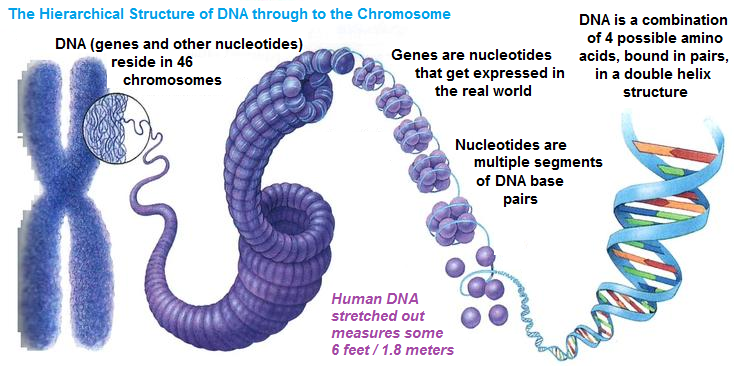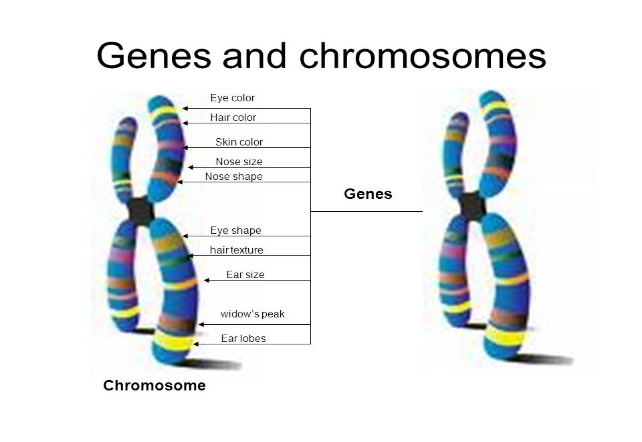A gene is the fundamental physical and functional element of heredity. Genes are composed of DNA. They contain specific instructions for protein synthesis.
Genes are located in chromosomes. The body cells have a constant number of paired chromosomes. The two chromosomes of a pair are known ashomologous chromosomes. In human body cells, there are 23 pairs of homologous chromosomes for a total of 46 chromosomes.

Chromosome is made of chromatin material (simply as chromatin). Chromatin is a complex material, made of DNA and proteins (mainly histone proteins). DNA wraps around histone proteinsand forms round structures, called nucleosomes. DNA is also present between nucleosomes. Inthis way, the nucleosomes and the DNA between them look like “beads on a string”. The fibers consisting of nucleosomes condense into compact forms and get the structure of chromosomes.
DNA is the genetic material i.e. it contains the instructions to direct all the functions of cells. It performs its role by giving instructions for the synthesis of specific proteins. Some proteins perform structural roles while the others act as enzymes to control all biochemical reactions of cells. In this way, whatever a cell does, actsually controlled by its DNA. In other words, DNA makes the characteristic or trait of cell or organism.
Traits are made by specific proteins. Specific proteins have specific number and sequence of their amino acids. DNA controls this sequence of amino acids by the sequence of its nucleotides. During protein synthesis, the sequence of DNA nucleotides decides that what will be the sequence of amino acids. For this purpose, the specific sequence of DNA nucleotides is copied in the form of messenger RNA (mRNA) nucleotides. This process is called transcription. The mRNA carries the sequence of its nucleotides to ribosome. The ribosome reads this sequence and joins specific amino acids, according to it, to form protein. This step is known as translation. The part of DNA(sequence of nucleotides) that contains the instructions for the synthesis of a particular protein is known as a gene. DNA of each chromosome contains thousands of genes. Like chromosomes, genes also occur in pairs, one on each homologous chromosome. The locations or positions of genes on chromosomes are known as loci (Singular: locus).

Each gene determines a particular trait in an organism. Each individual carries at least one pair of genes for each trait. Forconvenience, pairs of genes are represented by a letter or symbol. Both members of a gene pair may be the same in some individuals (a condition which we may represent as AA or aa or BB) and different in others (Aa or Bb). It means that a gene exists in more than one alternate forms. In the above example, ‘A’ and ‘a’ are the two alternate forms of a gene and ‘B’ and ‘b’ are the alternate forms of another gene. The alternate formation of a gene is usually called alleles. If a person has Aa gene pair, ‘A’ and ‘a’ are the alleles of one another.
In this individual, allele ‘A’ is located on one of the two homologous chromosomes and the allele ‘a’ is on the other chromosome. When chromosomes separate during meiosis, alleles also separate and each gamete gets one of the two alleles. When gametes of both parents unite, the zygote (and the offspring also) receives one allele from each parent.